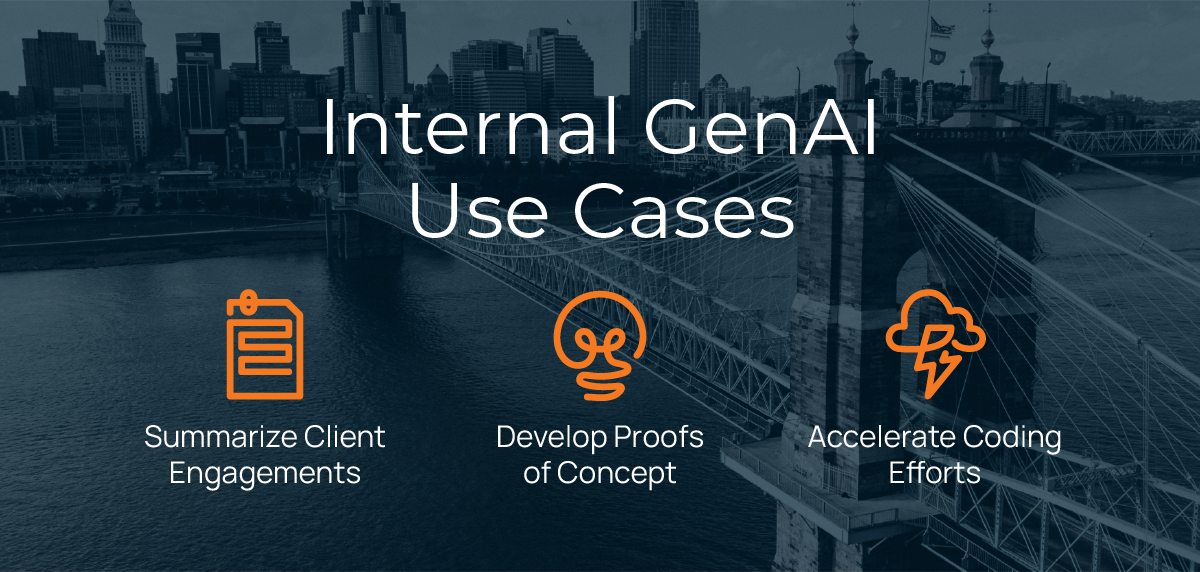Blog
Internal Use Cases for GenAI
The long-gone days of switchboard operators and buggy whip makers prove that those unable to adapt to technology are doomed to be replaced by it. Businesses are now focused on developing and refining AI strategies to incorporate new solutions and use cases for generative AI. This is a unique moment, as innovation is rapidly accelerating with advanced tools and capabilities are more accessible than ever.
As technology has changed, so have people’s expectations. In many cases, leveraging AI has shifted from a differentiator to a fundamental business requirement. AI can provide a competitive advantage in terms of both cost and utility, and there’s a growing demand for customer-facing AI experiences across industries, from sales and services to finance and healthcare.
The goal of integrating AI is to develop more efficient, faster or cost-effective business processes without harming quality. As businesses continue to explore possibilities and develop best practices and policies for genAI, Mission Cloud has identified opportunities and internal use cases that align with our objectives. Now is a great time to learn how others in your industry use AI and find ways to build from established frameworks and proven systems.
The Potential of GenAI
Undoubtedly, genAI is already making an impact, and its potential is far from fully realized in any industry. When, where and how it’s used can be as diverse as the people and companies adopting it. Many are enthusiastic about the future, but looking beyond the hype and developing realistic and achievable expectations is essential.
New use cases and solutions will continue to be developed, with many designed to be customized or purpose-built for a specific challenge or niche. In real estate, for example, agents can use publicly available property photos while automatically blurring images of people to ensure privacy. In healthcare, researchers can review and summarize health data with automatically removed personally identifiable information (PII).
In many ways, companies are just scratching the surface of what’s possible with genAI. Organizations that are highly motivated and willing to invest will succeed. Others may have inflated expectations, be distracted by pricing, or view AI as an all-encompassing solution that requires little to no effort. The truth is, genAI can be a powerful tool to help you reach your goals, but it’s only a tool. You can’t expect a large language model to completely replace the work of people, nor should you expect a free service to provide the security and accuracy of a custom solution. Devoting time to experiment and understand the technology allows you to realize more of its potential.
Each new AI development provides an opportunity to improve and expand functionality. “Think of this as the evolutionary landscape,” says Mission Cloud Data Science Consultant Max Goff. It’s critical to be able to test possible solutions for fitness in the environment to pass on beneficial traits to future developments. We’ve already seen models that are capable of reducing time spent on tasks from hours to minutes. With effective testing, you can identify opportunities to continue to evolve your processes.
The Power of Language
The potential for genAI to unlock a new range of use cases is exciting, but remember to stay grounded and focus on the practical applications of the technology rather than the hype. Language is the foundation of communication, and genAI has the potential to greatly improve how we interact with each other and with the world around us.
AI-driven language models can be used to process large amounts of data faster, better and more accurately than ever before, and they can be used to create natural language processing (NLP) applications that can analyze, interpret and interact with users.
The challenge lies in how to contain AI-driven language models to be used reliably in a software engineering environment. Companies must understand why these models do what they do, and ensure that their behavior is repeatable and predictable. As technologists and data scientists, it's our job to develop these models so that they can be trusted to produce reliable results.
The potential of genAI is immense, and as businesses continue to explore and develop best practices for AI, it's essential to remember that the power of language is at the forefront.
GenAI on AWS
In working closely with AWS, Mission Cloud sometimes has the opportunity to work with new services and technologies, such as Amazon Bedrock, to experiment and develop a better understanding of AWS tools. Bedrock offers a secure way to privately manage foundation models (FMs) from Amazon and leading third-party AI companies using your own data. The service enables users to use existing tools to customize, integrate and deploy FMs into applications without managing infrastructure.
Foundation models available from Bedrock are designed to work with a variety of use cases, and you can fine-tune them to suit your needs. For example, the Amazon-built model, Titan, offers text summarization, generation, open-ended Q&A, embeddings and more. Anthropic’s LLM is a great option for content creation, complex reasoning and creativity, while Stable Diffusion can generate unique, realistic and high-quality images, art, logos and designs.
In addition to Bedrock, foundation models can also be accessed through Amazon SageMaker JumpStart. Customers can launch SageMaker Studio and work with a variety of pretrained models, example notebooks and prebuilt solutions.

Internal GenAI Use Cases
AWS offers a robust suite of AI tools and continuously works to expand its offering. Meanwhile, new tools, models and services are emerging regularly. This fierce competition is a good indication that there’s a strong belief in the future of genAI.
Instead of taking the misguided approach of promising the moon only to scale back to reality, Mission Cloud is focused on finding specific use cases where large language models can add value to a business process. A well-designed solution, for example, may include LLMs as an essential part of an application rather than an application itself.
Here are three internal use cases Mission Cloud developed to incorporate genAI into our work:
Summarize Client Engagements
Every customer is unique, but many share similar pain points and the process for resolving solutions is often similar as well. With genAI, Mission Cloud can quickly review key details from client communication to develop draft proposals and other documentation to accelerate the sales process.
Using Amazon Bedrock, Mission Cloud can quickly and accurately distill key elements from conversations, transcripts and other engagements to provide insights that can be used to inform an engagement document. This process has been highly effective for Mission Cloud and has enabled us to create more effective proposals and SOWs in a fraction of the time.
GenAI also provides the ability to develop meaningful insights from customers using available information, such as using a URL to generate a business summary and identify salient points on a company’s objectives and goals. This capability has been particularly useful for developing detailed and accurate responses to Request for Proposals (RFPs) in a timely manner.
Develop Proofs of Concept
Quickly producing a proof of concept can be a challenge, and using Jupyter Notebooks to present them is less than ideal, especially if customers aren’t comfortable interpreting them. Mission Cloud has been exploring ways to leverage LLMs to create a GUI interface to provide a more user-friendly and visually appealing demonstration. This method can quickly generate code with a browser-based interface that shows inputs, processing and outputs.
LLMs provide a more efficient way to develop POCs by speeding up the process and reducing the amount of manual coding required. Processes that have traditionally required a full day can be completed in just a few minutes.
Accelerate Coding Efforts
Using LangChain and AWS, Mission Cloud’s Senior Product Marketing Manager Casey Samulski has been able to develop sophisticated agents without extensive technical experience. He described the process as a paradigm shift, explaining that “the border between coder and non-coder has been made extremely porous.”
Casey’s goal for the project was to develop a way for the marketing department to use a set of data, such as a CSV file, to generate a response based on predetermined parameters. After exploring LangChain, he developed a modular agent capable of working with any list of inputs formed as a CSV to generate custom outputs; his pilot project was 14,000 words of new enablement content built for the sales team.

Preparing for the Future
Businesses need to understand their data and what they hope to achieve to get the most out of generative AI. A successful AI strategy requires taking the time to evaluate the data available, the goals of the business and the potential solutions that best fit the problem. As companies look to the future of genAI, the importance of collaboration and readiness can't be overstated.
Working with an experienced AI partner, such as Mission Cloud, can help you navigate this process and provide a trusted perspective and guidance in developing a roadmap to success. This includes a clear understanding of the data, your desired goals and a plan for how to get there.
Are you ready to see how genAI can benefit your business? Connect with us to schedule a complimentary 60-minute consultation with one of our AI specialists to discuss your ideas, concerns and needs.
FAQ
How does generative AI ensure data privacy and security, especially when dealing with sensitive information like PII in healthcare applications?
Ensuring data privacy and security when using generative AI, particularly with sensitive information like personally identifiable information (PII) in healthcare, is paramount. Generative AI technologies incorporate advanced algorithms designed to generate new data and insights while meticulously handling existing data. To safeguard privacy, these systems often use data anonymization and pseudonymization techniques, effectively obscuring the details of individuals' identities before any analysis or processing occurs. Additionally, implementing robust access controls, encryption in transit and at rest, and adhering to compliance standards such as HIPAA in the healthcare sector are crucial to ensuring that sensitive information remains protected. It's also essential for these AI systems to undergo regular security audits and updates to address any potential vulnerabilities promptly.
What are the potential ethical considerations or implications of using generative AI for creating realistic media, such as images or videos, within an organization?
The ethical considerations surrounding the use of generative AI are complex and multifaceted. As these technologies become increasingly capable of producing highly realistic images, videos, and audio recordings, concerns about misinformation, deepfakes, and the erosion of trust in digital content have surfaced. Organizations leveraging generative AI for media creation must navigate these ethical waters carefully, implementing guidelines and policies that promote transparency, consent, and the accurate representation of individuals and events. This might include disclosing the use of AI-generated content to viewers and implementing verification processes to ensure that the creation and distribution of such content do not infringe on rights or propagate falsehoods.
How can businesses measure the ROI (Return on Investment) of implementing generative AI solutions for internal use cases, such as content creation or data analysis?
Measuring the return on investment (ROI) of generative AI solutions in business applications requires a strategic approach, focusing on both quantitative and qualitative benefits. Quantitatively, businesses can track metrics such as cost savings from automated content creation versus traditional methods, increased efficiency in data analysis processes, and the impact on revenue from enhanced customer engagement strategies. Qualitatively, the improvement in content diversity, the ability to generate insights from large datasets, and the enhancement of creative processes within an organization represent significant value. By setting clear objectives and benchmarks before implementation and continuously monitoring performance against these goals, businesses can effectively evaluate the ROI of generative AI technologies and make informed decisions about scaling their use for internal applications.
Check out this blog article, Get Answers to Frequently Asked Questions About Generative AI, for more frequently asked questions about generative AI.
Author Spotlight:
Ryan Ries
Keep Up To Date With AWS News
Stay up to date with the latest AWS services, latest architecture, cloud-native solutions and more.

